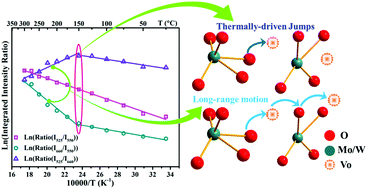Unraveling the correlation between oxide-ion motion and upconversion luminescence in β-La2Mo2O9:Yb3+,Er3+ derivatives†
Abstract
An optical approach is an alternative method to give insight into the oxide-ion motion in oxide-ion conductors. Herein, we illustrate the correlation between upconversion (UC) luminescence in Yb3+–Er3+ and oxide-ion motion in a β-La2(Mo,W)2O9 series. The break points at ∼150 °C in the logarithmic UC emission intensity ratio of I525/I660 or I660/I550 (the three emission peaks of Er3+) versus temperature imply oxide-ion jumps, whereas the slopes of these plots above 150 °C suggest the capacity of oxide-ion motion. Specifically, the larger the absolute slope values, the higher the oxide-ion conduction capacity. Due to the pinning feature of the Fermi level contributed by the Mo–O bonds in β-La2Mo2O9 both with and without anion-Frenkel defects or W dopants, as revealed by density functional theory calculations, β-La2Mo2O9 remains electronically insulating. Thus, the increase in activation energy and decline in conductivity with an increase in W contents at low temperature (<400 °C) are likely attributed to the higher barrier for the formation of new anion-Frenkel defects. This research gives another perspective on oxide-ion conductors via an optical probe.



 Please wait while we load your content...
Please wait while we load your content...